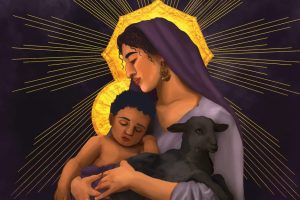When seen with eyes of faith, calendars help us keep time with Christ.
More than any particular element of Catholic spirituality, the church’s calendar gives me comfort. It offers the hope that I can progress in my spiritual life, even in areas where I have failed in the past. Every year provides one more round of seasons with Christ, one more chance at new insight, one more year of grace.
The rhythms of the church calendar also do something I often despair of in my personal life. They sanctify time, claim it for Christ, and make him the focal point of every season.
Each year on the First Sunday of Advent, from a cluttered upstairs room, we dig out the old Advent wreath from the boxes of Christmas decorations in the deep cabinets under the bookcase next to my desk. My father-in-law, who was Jewish and a cabinetmaker by trade, built the bookcase, the cabinets, and the desk. Though he is dead now, we remember him in the things he created.
When we dig out the Advent wreath and the Christmas decorations, we dig out memories stored in memories, hoping to create new ones. The liturgical year is like that for me—in the present, looking back, looking forward, all at once, and everywhere the presence of a Jewish carpenter.
Jesus lived his life in sync with the rhythms of the Jewish liturgical seasons. For us Catholics he is the fulfillment of those ancient feasts. Early Christians inherited that Jewish calendar, and our year retains many of its elements in the readings and feast days we celebrate. The early church adapted and built on that Jewish foundation; the timing of the Triduum and Pentecost are the prime examples. This heritage can be found in our scriptures, too, with John’s gospel based on the Jewish cycle of feasts.
Holy Saturday is usually windy in my part of the country, and last year was no exception. The sun fell below the horizon as the Easter Vigil began, and Father Tom, vestments flapping and sparks flying in the breeze, fired up that most mundane of liturgical vessels, the Weber Kettle, and proclaimed that Jesus Christ “is the Alpha and Omega, the beginning and the end. All time belongs to him, Christ our light.” The paschal candle was no sooner lit than the struggle to preserve the flame began. The wind prevailed; the candle was extinguished before Father Tom had taken five steps toward the church. As he entered the narthex a taper from the Weber relit the candle, and he again sang out, “Christ our light!” safe within the confines of the church.
My spiritual life is not much different. Each year I start off full of fire, but the light of Christ flickers out before the echo of the last Christmas carol has faded. Often I am not even aware of my situation; the competing glow from TV, PC, and movies deceives me, until at some point I notice I am carrying a candle without a flame. Before a cock can crow three times I need a relight.
Fortunately Christ and the church are patient tutors. Every year we cover the same basic lessons. I am exhorted week in, week out, year after year, to begin again—and again—on the project of conforming myself to Christ.
Like most of our lives, the liturgical year is mostly ordinary time. During the Ordinary Time of the liturgy I contemplate and internalize the “ordinary time” of Jesus’ mission. Between his Advent and Resurrection, Jesus interacts with friends, beggars of mercy, and adversaries—all roles that I play on any given day. It is also in Ordinary Time that I celebrate those collaborators with Christ, the ordinary people made holy by their relationship with Christ. The saints, led by Mary, include men and women who stumble, fall, speak out of turn, and even deny Jesus, yet still cling to him.
Each year I am reminded that all time belongs to Christ. Past, present, and future are all his. From Advent to Christmas, through Holy Week, to the Solemnity of Christ the King, I am constantly reminded of the history of God’s saving work in time. It is a perpetual remembrance of salvation history, just as the Mass is a perpetual remembrance that makes present Christ’s saving death and Resurrection and looks forward to his glorious return. It is the calendar of hope.
This article appeared on the January 2007 issue of U.S. Catholic (Vol. 72, No. 1, page 48).












Add comment